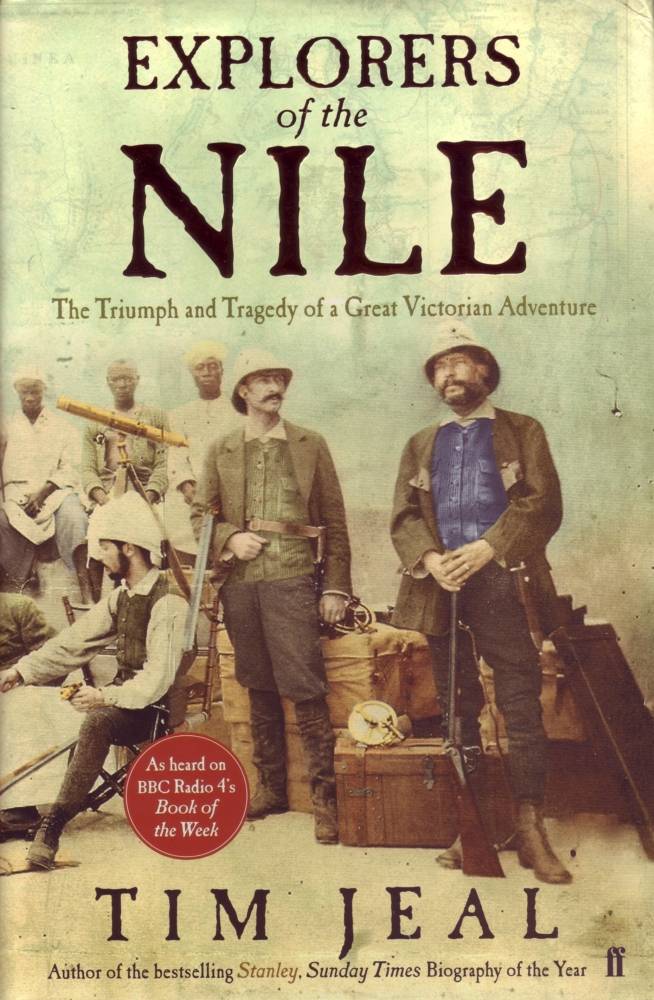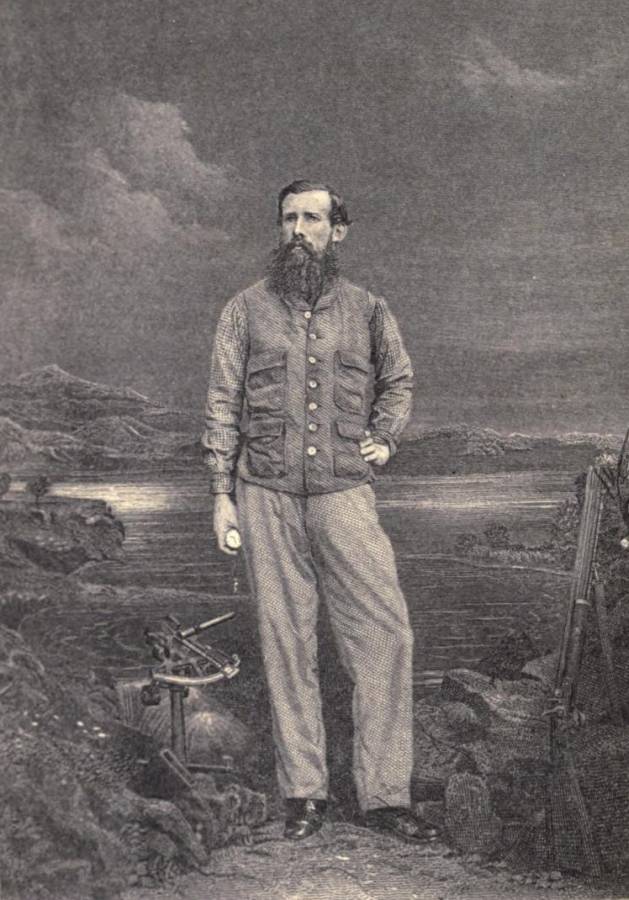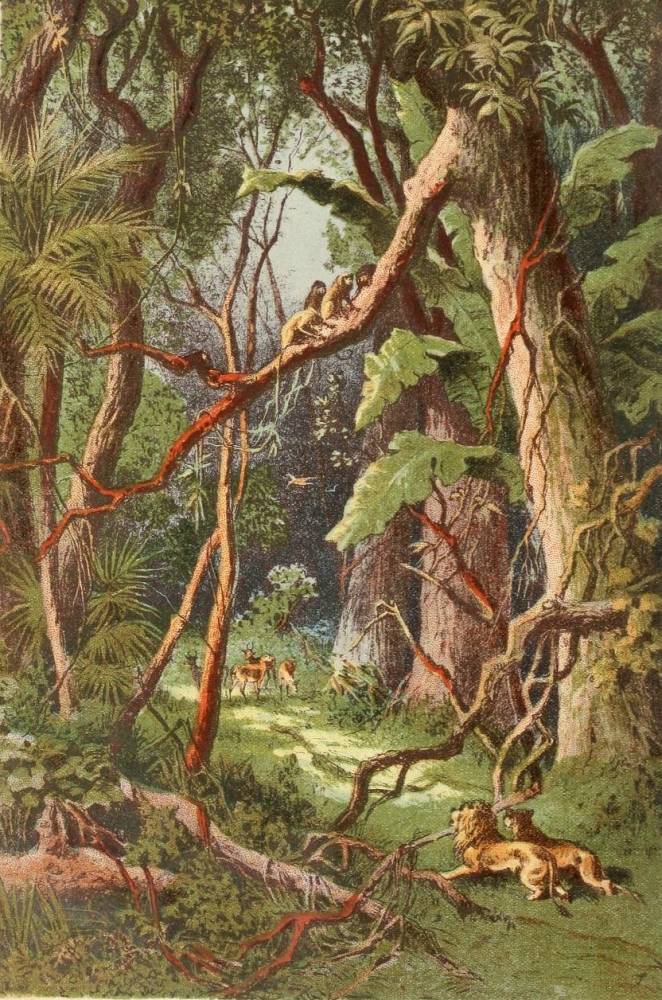
Cover of the book under review [Click on this and the following images to enlarge them.]
If you asked a Roman to do something impossible, he might have replied with the saying, Facilius sit Nili caput invenire: "It would be easier to find the source of the Nile." For centuries, adventurers, geographers and astronomers tried to locate this elusive spot. But all their efforts were in vain. Sometimes they came up with wrong guesses. The great Moroccan Berber traveller Ibn Battuta (1304-68), who had previously traversed Asia and later the Sahara, wrongly identified its source as the mouth of the Niger. Similarly, when James Bruce reached a wide river in 1790, he proclaimed that he had discovered the source of the Nile. In fact, he had only found one of its tributaries. In the end, it was left to the Victorians to elucidate this baffling mystery.
In Explorers of the Nile, Tim Jeal first retraces the various attempts by famous adventurers like David Livingstone and Richard Burton. These men went through the rough terrains of the unmapped territories of East and Central Africa and encountered formidable obstacles in the form of illness, disease, and the hostility of the native people. For instance, in one of the skirmishes with the hostile Somalis, a warrior thrust his javelin right at Burton: “The spear entered on one side of Burton's face and came out on the other, cleaving the roof of his mouth and smashing out two molars” (52). This left a permanent mark on him, which is visible in his portraits. These intrepid explorers took different routes, but for all their struggles did not succeed in their mission.

John Hanning Speke (!827-1864), from the frontispiece of his Journal of the Discovery of the Source of the Nile, a tall man with a "willowy figure" (45)
It was John Hanning Speke (1827-1864), who finally achieved this distinction in 1858. Speke, with his later conflicts with Burton, is the main focus of Jeal's book. Jeal points out that “most of Richard Burton's biographers have seen John Hanning Speke as being inferior to their own complex and multi-talented subject in virtually every respect” (45). But he shows that despite this, Speke achieved the goal which had eluded his more illustrious contemporary. Jeal first sketches the beginning of Speke's life, which was indeed quite unremarkable. He was born in Devon and went to Barnstaple grammar school. As a schoolboy, his academic performance was mediocre, but he showed proficiency in reading, analysing and drawing maps. Like his father, he decided to join the army. At the age of seventeen he was commissioned into the Indian army and joined the 46th native Bengal Infantry. He was soon involved in the First and Second Anglo-Sikh Wars (1845-6 and 1848-9). But during his ten-year stint in India he found the long intervals of peace boring. On such occasions he went hunting and collected trophies for the museum which he had established in his father's house (a typical Victorian hobby). During one of his holidays, he went to Tibet and explored that hitherto little-known country, collecting exotic trophies to bring home.
At the end of his commission in 1854, Jeal tells us, Speke went into the possibility of going to Africa. Fortunately, he found that he could join Richard Burton who was leaving for the Somali coast in an attempt to explore the southern region. There were problems from the start. In Somalia, Burton went westwards to the forbidden island Harar, asking Speke to reconnoitre the area known as Wadi Nogal. Speke was unfamiliar with this region and he was further handicapped by his ignorance of the local languages. Burton soon returned and planned an expedition to Berbera. His party was attacked there; Speke was severely beaten, left injured, and subsequently invalided back to England. But his spirit was indomitable, and he soon volunteered to serve in the Crimean War. While on a hunting trip to the Caucasus, he learnt about the possibility of joining Burton who was setting off again, this time to East Africa. The expedition was sponsored by the Royal Geographical Society (RGS) which had been founded to promote geographical science, and had received its Royal Charter from Queen Victoria in 1859. Among other projects, the RGS was especially keen to explore the uncharted territories of Africa. It asked Burton to go the African mountains and lakes, and it was hoped that he would solve the mystery of the source of the Nile. Burton was unwilling to go alone and, despite the alleged "incompatibility between the socially unconventional and highly intellectual Burton and the rather unimaginative and certainly unintellectual Speke" (Bridges), proposed “as [his] companion, Lt. Speke of the B A [Bengal Army]” (57). Speke gladly accepted Burton's invitation, and soon they both arrived in Zanzibar en route to the inner regions.
It is fascinating to see the RGS in action this time: Burton was instructed to “proceed northward towards the range of mountains [Mountains of the Moon] marked upon our maps as containing the probable source of the 'Bahr el Abiad' [the White Nile] which it will be your next great objective to discover" (70). But, initially, Burton confined himself to finding the Sea of Ujji (Lake Tanganyika), which was apparently his obsession. Burton and Speke trudged through the dense terrain, and after travelling for 134 days arrived at the Arab trading settlement in Tabora where they were very hospitably received by the Arab slave-owners. The Arabs told the visitors that there were three lakes in the vicinity: Lake Malawi to the south, Lake Ukerewe to the north and Lake Tanganyika to the west. Burton fell seriously ill, and Speke developed ophthalmic problems. Nevertheless, they continued their journey and arrived at Lake Tanganyika. It was the biggest lake that any European had seen — about 400 miles wide — and at an elevation of 1,850 feet. Burton was convinced that he had reached the mouth of the Nile. Unfortunately, though, his illness worsened and he became practically incapacitated. Speke in the meantime decided to go to the western part of the lake. After crossing the river, he took some rest. But he was attacked vigorously by beetles, one of which got into his ear. He tried to get it out but to no avail: “Neither tobacco, salt, not oil could be found: I therefore tried melted butter: that failing, I applied the point of a penknife to his back, which did more harm than good' (87-8). The insect was killed but Speke hurt his ear grievously, and suffered for it for the rest of his life. Still, Speke was undeterred. While he was on the western coast, he was excited to learn that there was a big river flowing north. When he reported this to Burton on his return, the latter was convinced that they were near the source of the Nile. However, Burton learnt soon afterwards that Speke's information was incorrect. He was devastated: “'All my hopes,' he confessed, 'were rudely dashed to the ground'” (90). But he was too weak to make any further investigations.



Left: The Victoria Falls. Middle: David Livingstone Monument, Lake Victoria. It seems a shame that there is no monument here to Speke, who gave the lake the name by which it is now known. Right: Bust of Livingstone on the façade of the Foreign Office, Whitehall, London.
At this point, remembering that Burton had previously expressed a desire to go to the northern lake which the Arabs called Ukerewe, Speke decided to go there on his own. He gathered a caravan of thirty-four men and set out on 9 July 1854. After about three weeks the party entered a valley nearing a vast lake. On arriving at the lake, Speke was again convinced that he had reached his destination. He made this claim in print later on: “I no longer felt any doubt that the lake at my feet gave birth to that interesting river, the source of which has been the subject of so much speculation, and the object of so many explorers” (99). Locally, the lake was called Nyanza, but Speke decided to name it Lake Victoria. Local rivalries prevented him from making further explorations, so he returned to Burton and told him of his discovery. Burton did not want to be upstaged. Because of jealousy or spite, he was reluctant to believe what Speke told him, and said more reconnaissance was needed. He, of course, was too ill to undertake such a journey. So they both decided to go back to Aden and return to England. However, the doctor at Aden forbade any further travel for Burton, so Speke ended up going back alone.
Burton later claimed that he and Speke had promised to go to the RSG together to report on their journey to the north. But, once in England, Speke made his Nile claim public and published his findings in Blackwood's Edinburgh Magazine in 1859. He wrote, “18 July: Here at last I stood on the brink of the Nile: most beautiful was the scene, nothing could surpass it! . . . I told my men that they ought to shave their heads and bathe in the holy river, the cradle of Moses — the waters of which, sweetened with sugar, men carry all the way from Egypt to Mecca, and sell to their pilgrims” (Hanbury-Tenison 171). This of course completed the breach between the two explorers. An infuriated Burton wrote to RGS expressing his doubts about Speke's claims.

Frontispiece illustration from the beginning of Stanley & Africa
Matters could not be left like this. The RGS acted on the letter by sending Speke back again to verify and document his assertions. This time, Speke recruited John Grant, a friend from his regiment in India, and they both set out, together with their team, for East Africa. They arrived in Zanzibar in 1860. They trekked from the coast into the interior, their destination being the western coast of Lake Victoria. On the way, they encountered terrible obstacles — the desertion of porters, the hostility of the locals and the non-cooperation of local chiefs. On top of this, Grant's health gave way and he was temporarily disabled by a leg ulcer. He had to be left behind, as Speke determinedly moved north to Buganda. Here he was well received by the Bugandan king, who asked his men to show Speke the way to the north of Lake Victoria. Reaching spectacular falls known locally as "The Stones" in July 1862, Speke was convinced that he had arrived at his destination, and christened them the Ripon Falls. He wrote in his journal on 21 July 1862, “'Here at last I stood on the brink of the Nile; most beautiful was the scene, nothing could surpass it.'” (167). He telegraphed the RGS that “'the Nile is settled'” (189). But this was merely an assertion, not scientific proof. He did not follow the Nile river closely. This led his critics, especially Burton, to question his claims yet again.
On his return, Speke wrote about his discovery under the title, The Journal of the Source of the Nile in 1863. This was published by Blackwood. Sir Roderick Murchison, the president of the RGS, was annoyed: he would have preferred it to have been published in the official journal of the RGS. He got the chance to punish Speke when Livingstone “confided to Sir Roderick Murchison, that he, like Burton, believed the Nile's source was more likely to lie in Lake Tanganyika than in the Victoria Nyanza” (201). Murchison arranged a debate between Speke and Burton in order finally to settle the matter.
Of all the ordeals Speke had been through, this was perhaps the worst. He was clearly rattled by the prospect of a debate with the formidable Burton, with Livingstone in the chair. The day before it was scheduled, he attended a lunch at which Burton was also present. Without finishing his lunch, Speke went off to Wiltshire, and set out with his cousin to shoot partridges at Neston Park. While climbing a wall, he accidentally fell and shot himself. Though the jury returned a verdict of “accidental death,” many people, especially Speke's enemies, remained unconvinced. They alleged that Speke shot himself because he felt that he would be humbled by Burton. Murchison was deeply grieved and perhaps felt that he had had a part in Speke's death. In compensation, and, with the Queen's consent, he called for an obelisk to be erected in his memory in Kensington Gardens. This was done in October 1866. However, the tribute on the memorial, “In memory of Speke, Victoria Nyanza, and the Nile 1864,” is ambiguous, and makes no mention of Speke as the discoverer of the source of the Nile. This was only rectified in 1995, with the laying of a new, more informative plaque on the grass in front of the monument.


The Speke Monument, Kensington Gardens, London, and the plaque added in 1995, which does him fuller justice.
The Royal Geographical Society then tried to confirm Speke's claim by sending out explorers like Samuel White Baker and Livingstone; but they only discovered other big lakes like Luta N'zige (Baker) and Lualaba (Livingstone). It was finally Henry Morton Stanley who authenticated Speke's claims. With the financial support of the Daily Telegraph and the New York Herald, Stanley set out for Africa in 1874. He went to Lake Victoria on his boat Lady Alice and circumnavigated the whole vast expanse. Convinced now, he wrote in the New York Herald, “Speke had been most accurate in his description of the outgoing river” (301). Tim Jeal's summation of the whole enterprise is: “Speke's case was proved, and Burton's and Livingstone's had been destroyed” (315).

Title page from the beginning of Stanley & Africa, showing a suitably dignified Stanley among the natives. Nothing could better illustrate the Victorians' mingled curiosity and sense of superiority; also, in retrospect, the greyness of the west, and the vibrancy of the peoples in this newly charted territory.
Tim Jeal has written an entertaining account of the life and adventurers of the Victorian explorers. Historians, of course, have examined and established all the facts given here. Jeal is aware of their findings and has done his own research as well. For example, he has consulted unpublished sources like the manuscript of Speke's book, The Journey of the Discovery of the Source of the Nile (1863), which had been censored by his original publisher John Blackwood. And following the modern trend among writers of popular histories, Jeal has added all the scholarly paraphernalia of notes and bibliographies. But, mercifully, his account is free from academic jargon. Jeal is also a novelist, and he has spiced up the known facts about the explorers by reviving the personal animosities and conflicts between the different explorers (especially Burton and Speke, whose partnership he describes as a “great misalliance,” 36); and by recounting the terrible illnesses that afflicted them, Speke's sexual adventures in Africa — which possibly resulted in the birth of a child — and tales of native kings with literally hundreds of wives. All in all, Jeal has written an eminently readable book.
Bibliography
Bridges, Roy. "Speke, John Hanning (1827-1864). Oxford Dictionary of National Biography. Online ed. Web. 5 Dec. 2011.
Hanbury-Tenison, Robin. Exploration. Oxford: Oxford University Press, 2005
Jeal, Tim. Explorers of the Nile: The Triumph and Tragedy of a Great Victorian Adventure.. London: Faber, 2011. 510pp. £25.00. ISBN 978-0-571-24975-6.
Speke, John Hanning. Journal of the Discovery of the Source of the Nile. New York: Harper, 1864. Internet Archive. Web. 5 Dec. 2011.
Stanley and Africa: Also the Travels, Adventures, and Discoveries of Captain John H. Speke, Captian Richard F. Burton, Capotian Jones W. Grant, Sir Samuel and Lady Baker, and Other Distinguished Explorers. London, Walter Scott, 1890. Internet Archive. Web. 5 Dec. 2011.
Last modified 17 February 2020